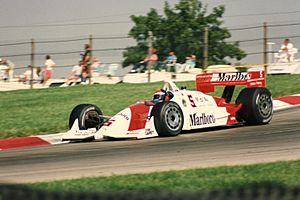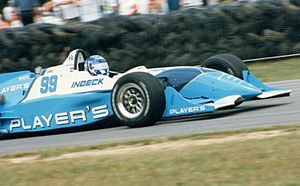Championship Auto Racing Teams facts for kids
 |
|
| Sport | Auto racing |
|---|---|
| Jurisdiction | United States, Canada |
| Abbreviation | CART |
| Founded | 1979 |
| Headquarters | Troy, Michigan, United States (1979-2002) Indianapolis, Indiana, United States (2002-2003) |
Championship Auto Racing Teams (CART) was a group that organized and promoted American open-wheel car racing. It ran from 1979 to 2003. CART was in charge of the PPG Indy Car World Series during these years.
CART started in 1979. It was created by team owners from the United States Auto Club (USAC) Championship Division. They disagreed with how USAC was running things. Their new idea was for car owners to work together. They wanted to organize and promote their own racing series.
Through the 1980s, the Indy Car World Series became very popular in North America. It featured races on street circuits, road courses, and oval track racing. CART drivers also continued to race in the Indianapolis 500, which was run by USAC.
Even as the series grew, some problems appeared. These included rising costs and disagreements about how money was shared. In 1992, the company changed its name to IndyCar to try and fix things. But these efforts did not work out.
In 1996, a big disagreement, called the "split," happened. A new group, the Indy Racing League (IRL), took over the Indianapolis 500. They also started their own racing series focused on oval tracks. CART stopped using the IndyCar name. They continued their series without racing in the Indianapolis 500.
The "split" caused less interest in open-wheel racing in the United States. Also, NASCAR became more popular. This led to less sponsorship money and fewer fans at some races. After some major racing teams and engine makers left for the IRL in the early 2000s, CART went out of business at the end of the 2003 season.
In 2004, three team owners bought CART's assets. They renamed it the Champ Car World Series. But this series also faced money problems. It went bankrupt before its planned 2008 season. Its history and assets then joined the IRL's IndyCar Series. This brought American open-wheel racing back together.
Contents
What Were Champ Cars Like?
Champ Cars were special open-wheel racing cars. Before 1997, they were called IndyCars. They had only one seat and the engine was in the middle. These cars had special shapes underneath to help them stick to the track. They also had large wings to create downforce. This helped them go faster around corners. Teams would use different parts for the cars depending on if they were racing on an oval or a road course.
Teams usually bought their car frames (called chassis) from companies like Lola, Swift, Reynard, and March. Some owners, like Dan Gurney and Roger Penske, even built their own.
For tires, only Goodyear was used until 1995. Then, Firestone joined, creating a big competition. Firestone became the only tire supplier in 2000. Their parent company, Bridgestone, took over in 2003.
Champ Cars used turbocharged engines. These engines ran on methanol fuel. Engine makers like Cosworth (often called Ford-Cosworth), Ilmor (called Chevrolet), and Buick were common in the early years. By the mid-1990s, Mercedes-Benz, Honda, and Toyota also started making engines.
Teams usually rented engines from the manufacturers. These companies would improve the engines during the racing season. An engine that was great at the start of the season might fall behind later. Sometimes, only certain teams got the best engines. This caused arguments within CART. In 2003, after Honda and Toyota left, CART bought many identical Cosworth engines. They then rented them to teams under the Ford name.
Champ Cars looked a lot like Formula 1 cars. Both had wings, mid-engines, and open wheels. But Champ Cars were heavier and bigger because they raced on ovals. They were slower to speed up but could reach higher top speeds. Sometimes, they had more powerful engines than F1 cars. Both series tried not to compare themselves too much. But in 2002, both raced on the same track in Montreal within a month. F1 cars were faster on that track.
History of CART Racing
How CART Started
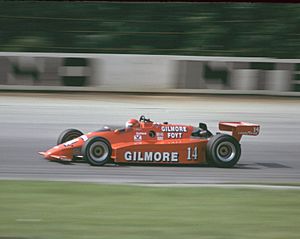
In 1905, the AAA started a national driving championship. They were the first group to organize auto racing in the U.S. After a big accident in 1955, the AAA stopped. So, Indianapolis Motor Speedway president Tony Hulman formed the United States Auto Club (USAC). USAC took over organizing "championship" auto racing. The biggest race was the Indianapolis 500. USAC was the only group in charge until 1978.
But racers like Dan Gurney started to criticize USAC in the 1970s. They were unhappy about things like losing a big sponsor. They also disliked that some races were on dirt tracks. They felt the prize money was too low. And they thought USAC wasn't doing enough to promote the races.
In 1978, Dan Gurney wrote a plan called the "Gurney White Paper." It suggested forming Championship Auto Racing Teams (CART). This group would help promote USAC's championship. CART would also work to get TV rights, sponsorships, and better prize money. They hoped to have a say in USAC's decisions. In 1978, USAC had 18 races, with 4 on road courses and 14 on oval tracks.
In April 1978, eight top USAC officials died in a plane crash. This caused big problems for the 1978 season. In November 1978, Gurney and other team owners, like Roger Penske, presented their ideas to USAC. But USAC rejected their plan. This led to the creation of a new, separate racing series. The first CART race was on March 11, 1979. The Sports Car Club of America helped organize it.
USAC tried to stop CART drivers from racing in the 1979 Indianapolis 500. But CART won a court order that allowed their cars to qualify. In 1979, 13 of the 20 races were part of the CART Championship. USAC and CART tried to work together in 1980, but USAC pulled out after 5 races. By the end of 1981, the Indianapolis 500 was the only major race still run by USAC.
CART PPG Indy Car World Series (1982–1991)
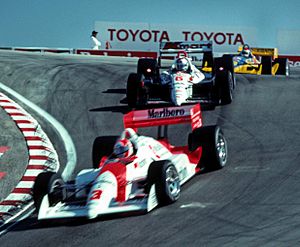
By 1982, the CART PPG Indy Car World Series was seen as the top open-wheel racing championship in America. In 1983, USAC agreed to let the Indy 500 be part of the CART schedule. Drivers would get points for the CART championship. In return, USAC kept control of the Indy 500 race itself.
At first, CART mostly raced on oval speedways, like USAC. But then, the series started racing on famous road courses. These included Road America, Mid-Ohio, and Laguna Seca. Many racing stars like Mario Andretti, Bobby Rahal, and Danny Sullivan became successful in CART. By the mid-1980s, CART also started holding street races. They took over races like the Detroit Grand Prix and the Grand Prix of Long Beach from Formula One. They also expanded to Toronto and Cleveland. CART was also the first series to have a full-time safety team that traveled to every race.
For the first time, open-wheel racing outside of Indianapolis had a steady schedule. This brought more sponsors and TV opportunities for the teams. Attendance, TV money, and prize money all increased. However, CART's way of being run, where everyone was equal, caused some problems. CART owners were very different. Some, like Carl Haas and Roger Penske, owned racetracks and had big deals with tire, car frame, and engine makers. Other teams just bought older cars and raced when they could afford it. These different interests led to yearly arguments about rules, sponsors, safety, and track choices.
In 1988, CART joined ACCUS. This allowed foreign drivers to race without losing their international racing licenses. With former F1 champion Emerson Fittipaldi winning the CART title in 1989, more drivers from South America and Europe joined. This made the series popular for TV networks around the world. CART held its first race outside North America in Australia in 1991.
IndyCar and the "Split" (1992–1996)
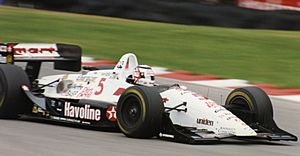
As bigger teams and engine makers competed, costs went up fast. This made it hard for smaller teams to afford to race. Tony George, who was president of the Indianapolis Motor Speedway (IMS) by 1989, and others felt that foreign drivers and street races were stopping American talent from racing in IndyCar. Also, NASCAR, which mostly raced on ovals, was becoming more popular in the Midwest.
CART was often accused of only helping the team owners, especially the richest ones. The owners believed that since they took the most risks and spent the most money, they should control the sport. CART owners also didn't like Tony George. They felt his close ties with USAC meant he could easily stop their involvement in the Indianapolis 500. For years, there were debates about how the sport should be run. IMS didn't want to share money or control over Indianapolis. Owners didn't want to give too much power to track promoters. To try and fix this, CART changed its name to IndyCar in 1992. They also formed a new board. Owners elected five members with votes. The IndyCar CEO and Tony George had non-voting seats.
In 1993, British driver Nigel Mansell, who was the 1992 F1 champion, switched to IndyCar. He won the championship that year. But the new board broke down at the end of the season. This was after some controversial decisions. These included shutting out Japanese engine makers and canceling a race in the UK. These decisions seemed to be driven by conflicts of interest from George and the elected owners.
In March 1994, George left the IndyCar board. That year, Team Penske used a special Mercedes-Benz engine for the 1994 Indianapolis 500. This engine took advantage of a rule difference between USAC and IndyCar. They dominated the race, which made people worry about costs getting out of control. In July, IMS announced they were starting the Indy Racing League (IRL). This new series would control costs and race only on American ovals. It would be run by USAC.

After the 1995 Indianapolis 500, drivers complained about USAC's management. So, George announced a new rule for the 1996 Indianapolis 500. The top 25 drivers in IRL points would automatically get a spot in the race. This left only 8 spots for others. This was called the "25/8 Rule." It was new because the Indy 500 always had open qualification for every spot. CART said they were locked out and would no longer race at Indianapolis. George said CART was boycotting. To keep sponsors happy, CART created a rival race. It was called the U.S. 500. It was held at Michigan International Speedway on the same day as the Indy 500 in 1996. In March, IMS tried to stop CART from using the "IndyCar" name in court.
Leading up to Memorial Day 1996, there was a public fight. CART owners and drivers were against George and IMS. Even Indy legends like the Unser and Andretti families criticized the new rules. They called the Indy 500 with less experienced drivers unsafe.
The 1996 Indianapolis 500 had many accidents. A quarter of the race was run under caution flags. Buddy Lazier won his first race. The US 500, which started during the Indy 500, had a terrible start. A twelve-car crash delayed the race for an hour. Jimmy Vasser, who won by 11 seconds, joked "Who needs milk?" This referred to the Indy 500 winner's tradition of drinking milk. Both at the time and looking back, that weekend was a disaster. It marked the start of a big decline in open-wheel racing. Both the Indy 500 and other IndyCar events saw a sharp drop in popularity, TV viewers, and attendance.
CART FedEx Championship Series (1997–2000)
After several lawsuits, CART agreed to go back to its original name after the 1996 season. The IRL agreed not to use the "IndyCar" name until the end of 2002. CART started calling its cars "champ cars." This term had been used before by USAC.
In the first few years after the IRL started in 1996, CART was much stronger. It had most of the famous races, sponsorship money, and well-known drivers and teams. It was also the preferred series for engine manufacturers. This was because the IRL banned engine rentals. The IRL's main asset was the Indianapolis Motor Speedway and its Indy 500 race. In 1996 and 1997, CART had exciting races with stars like Jimmy Vasser, rookie Alex Zanardi, and Michael Andretti. Meanwhile, the IRL had problems. These included a very wet 1997 Indianapolis 500 and strange engine sounds. They also stopped using USAC because of its poor management.
CART decided to sell shares to the public. They sold on the NASDAQ stock exchange under the symbol MPH. This raised $100 million by selling 35% of the company. This gave CART enough money to grow and buy the Indy Lights series. However, some people thought it was risky to make a racing company's finances public. Racing finances are often secret and change a lot.
Engine manufacturers tried to get CART and the IRL to use the same engine rules. But the IRL refused. The IRL started to find its place by working closely with new NASCAR-style oval tracks. The IMS's other businesses helped cover the IRL's large financial losses.
Despite the split, CART's yearly income grew from $38 million in 1995 to $68.8 million by 1999. Street races continued to make good money. Teams also gained some sponsorship money. But this success was not even. CART's traditional oval races in Michigan and Nazareth saw big drops in attendance. CART blamed this on poor marketing. TV ratings and income were low. The series received only $5 million per year for all its TV coverage. This was less than what some single NASCAR races got. While CART's stock was generally healthy, investors noticed its value changed based on how well merger talks with the IRL were going.
CART's championship battle in 1999 was between young stars Juan Pablo Montoya and Dario Franchitti. But it was overshadowed by the deaths of drivers Gonzalo Rodríguez and Greg Moore. They died within two months of each other. Moore's death at the 1999 Marlboro 500 raised serious safety concerns. This was especially true for the 500-mile races in Fontana and Michigan. Champ Cars reached average speeds near 240 mph there.
In 2000, after years of frustration, CART owners forced Andrew Craig to resign as CEO. Popular driver/owner Bobby Rahal took over temporarily. The board saw that street racing was still successful, but oval races were declining. So, they announced plans to move away from traditional tracks. They wanted more overseas ovals and street races to earn more money. This frustrated some traditional owners and U.S. sponsors.
Chip Ganassi, pressured by his main sponsors, also convinced the board to leave Memorial Day open. His team returned to the Indy 500 with Vasser and Montoya. Montoya put on a dominant show at Indy. He led 167 of 200 laps to win. The Ganassi team had an advantage because they put more engineering into their IRL-spec car. In 2000, Team Penske became strong again as Gil de Ferran won the driver's title.
Decline (2001–2003)
For 2001, CART planned its biggest schedule yet. It had 22 races in the United States, Canada, Mexico, Brazil, Japan, the UK, Germany, and Australia. Losing Homestead-Miami and Gateway to the IRL was supposed to be balanced by adding Texas Motor Speedway. This track had an exciting IRL race the year before. Bobby Rahal left to lead Jaguar Racing in Formula 1. Marketing expert Joseph Heitzler took over as CEO.
The Brazil race was canceled because the track promoters didn't pay. The race at Texas Motor Speedway had to be canceled on race day. Drivers were worried about blacking out from the high G-forces created by Champ Cars on the track's steep banks during qualifying. CART was praised for putting driver safety first. But the cancellation was a public relations disaster. CART was criticized for not testing cars on the track earlier. A lawsuit followed, which caused a loss for CART's stock. It also damaged its relationship with Speedway Motorsports forever.
Despite CART teams taking the top 6 spots in the 2001 Indianapolis 500, and a close four-way points battle, headlines focused on a technical issue. Honda and Ford had developed a new turbo pop-off valve. Toyota complained about it. When CART ordered changes to the valve to make competition fair, Honda got a court order to stop the change. This made all three manufacturers unhappy. Toyota announced it would move to the IRL for 2003 at the end of the season.
The series' first race in Europe, the German 500, was overshadowed by the 9/11 attacks. These happened the Tuesday before the Saturday race. Teams couldn't leave due to the worldwide shutdown of airspace. CART decided to run the race as planned after some debate. ESPN refused to show the race live. In this race, popular former champion Alex Zanardi lost both his legs in an accident. The series' first event in the United Kingdom almost got canceled due to track concerns.
To keep showing the Indianapolis 500, ABC/ESPN signed an exclusive TV deal with the IRL for 2002 and beyond. This forced CART to use Speed Channel for cable coverage. They also had to buy time on CBS to stay on broadcast TV. Team Penske announced after the season that they would permanently join the IRL in 2002. This was due to pressure from sponsor Marlboro.
Losing ESPN/ABC's exposure and engine manufacturer sponsorships started a downward spiral for the series. Race promoters began asking for lower fees for 2002. Sponsors also started reviewing their deals. Heitzler was fired by the CART board. Chris Pook, the respected CEO of the Long Beach Grand Prix, replaced him. Adding to the problems was CART's unstable ownership due to its public stock offering. Even though car owners were supposed to keep 65% of the stock, agreements allowed them to sell shares. As owners sold their shares, the board's problems grew more complex. Aggressive stockholders started pressuring the board and owners.
During the 2002 season, Honda announced it would move to the IRL the next year. This caused a big drop in CART's stock. It left Cosworth/Ford as the only engine maker for 2003. Attempts to pay teams to have enough cars racing, to avoid breaking contracts, led to even less cash and a lower stock price. Team owner Gerald Forsythe bought enough stock to control 22.5% of the voting shares with the board. Star driver Michael Andretti bought Team Green and moved them to the IRL, heavily influenced by Honda. Chip Ganassi Racing also left due to pressure from its main sponsor, Target.
In 2003, after FedEx stopped being the series sponsor, CART changed its name. It became "Bridgestone Presents The Champ Car World Series Powered by Ford". The series ran almost all its races on road courses. They used car frames from the year before.
Becoming Champ Car
CART ran out of money and declared bankruptcy after the 2003 season. Its assets were sold off. The IRL tried to buy the series to keep it from running. But three CART owners (Forsythe, Paul Gentilozzi, and Kevin Kalkhoven) along with Dan Pettit made a bid for CART's assets as Open Wheel Racing Series, LLC. The bankruptcy court decided that the OWRS bid was better for the people CART owed money to, even though it was smaller.
Champ Car continued to race until it also declared bankruptcy. It then "reunited" with the IRL in February 2008. The IndyCar Series now recognizes the records and champions of both series in its history.
Television Coverage
In its early years, TV coverage of CART races was shared by NBC, ABC, and ESPN. NBC left after 1990 but returned for one race in 1994. CBS also showed races from 1989 to 1991 and one race in 1995. ABC, ESPN, and ESPN2 continued broadcasting until 2001.
In the 2002 and 2003 Champ Car seasons, coverage was split between CBS and Speed Channel. Some races also aired on the high-definition channel HDNet.
Outside the United States, Screensport showed CART in the UK and parts of Europe from 1984-1992. Eurosport aired CART and Champ Car in Europe from 1993 until the series ended. In the UK, Sky Sports showed races from 1992. ITV also showed races at different times.
In Brazil, Rede Record aired the Indy 500 in 1984. From 1985 to 1992, Rede Bandeirantes aired the race and later the whole season. Between 1993 and 1994, Rede Manchete broadcast the CART season.
Then, SBT took over the rights from Manchete. They broadcast the entire season live from 1995 to 2000. However, from 1999, most races were delayed and shown late at night. The series was called "Fórmula Mundial" (Worldwide Formula) after the split. At first, it competed well with F1 broadcasts. But after races were moved to late-night, viewership dropped. SBT did not renew the contract after 2000.
Record again broadcast the series from 2001 to 2002, mostly delayed. But the shows were earlier in the evening. After low viewership in 2002, they didn't renew.
In 2003, RedeTV! broadcast the Champ Car series live again. But viewership was still low. They chose not to renew the contract after the 2004 season.
The Globo-owned SporTV channel broadcast the 2004 season. But they also did not renew the contract. This marked the end of CART/Champ Car broadcasting in Brazil.
Champions of CART
| Season | Driver | Team | Chassis/Engine | Jim Trueman Rookie of the Year |
|---|---|---|---|---|
| SCCA/CART Citicorp Cup | ||||
| 1979 | Penske Racing | Penske/Cosworth | ||
| CART PPG Indy Car World Series | ||||
| 1980 | Chaparral Racing | Chaparral/Cosworth | ||
| 1981 | Penske Racing | Penske/Cosworth | ||
| 1982 | Penske Racing | Penske/Cosworth | ||
| 1983 | Penske Racing | Penske/Cosworth | ||
| 1984 | Newman/Haas Racing | Lola/Cosworth | ||
| 1985 | Penske Racing | March/Cosworth | ||
| 1986 | Truesports | March/Cosworth | ||
| 1987 | Truesports | Lola/Cosworth | ||
| 1988 | Penske Racing | Penske/Ilmor–Chevrolet | ||
| 1989 | Patrick Racing | Penske/Ilmor–Chevrolet | ||
| 1990 | Galles-Kraco Racing | Lola/Ilmor–Chevrolet | ||
| 1991 | Newman/Haas Racing | Lola/Ilmor–Chevrolet | ||
| 1992 | Rahal/Hogan Racing | Lola/Ilmor–Chevrolet | ||
| 1993 | Newman/Haas Racing | Lola/Cosworth–Ford | ||
| 1994 | Penske Racing | Penske/Ilmor | ||
| 1995 | Team Green Racing | Reynard/Cosworth–Ford | ||
| 1996 | Chip Ganassi Racing | Reynard/Honda | ||
| PPG CART World Series | ||||
| 1997 | Chip Ganassi Racing | Reynard/Honda | ||
| CART FedEx Championship Series | ||||
| 1998 | Chip Ganassi Racing | Reynard/Honda | ||
| 1999 | Chip Ganassi Racing | Reynard/Honda | ||
| 2000 | Penske Racing | Reynard/Honda | ||
| 2001 | Penske Racing | Reynard/Honda | ||
| 2002 | Newman/Haas Racing | Lola/Toyota | ||
| Bridgestone Presents the Champ Car World Series Powered by Ford | ||||
| 2003 | Player's/Forsythe Racing | Lola/Cosworth–Ford | ||
Championships Won by Team
| Team | Championships | Last Win |
|---|---|---|
| 9 | 2001 | |
| 4 | 2002 | |
| 4 | 1999 | |
| 2 | 1987 | |
| 1 | 1980 | |
| 1 | 1990 | |
| 1 | 1995 | |
| 1 | 1992 | |
| 1 | 1989 | |
| 1 | 2003 |
Driver Fatalities
Sadly, four drivers died during CART-sanctioned events:
- Jim Hickman – August 1, 1982, during practice at Milwaukee Mile.
- Jeff Krosnoff – July 14, 1996, near the end of the Molson Indy Toronto race.
- Gonzalo Rodríguez – September 11, 1999, during qualifying at Laguna Seca Raceway.
- Greg Moore – October 31, 1999, during a race at California Speedway.
See also
 In Spanish: Championship Auto Racing Teams para niños
In Spanish: Championship Auto Racing Teams para niños
- IndyCar Series
- List of Champ Car circuits
- List of Champ Car drivers
- List of Champ Car fatal accidents
- List of Champ Car pole positions
- List of Champ Car teams
- List of Champ Car winners
- List of Champ Car drivers who never qualified for a race
- List of American Championship Car Rookie of the Year Winners
- List of American Championship car racing point scoring systems


